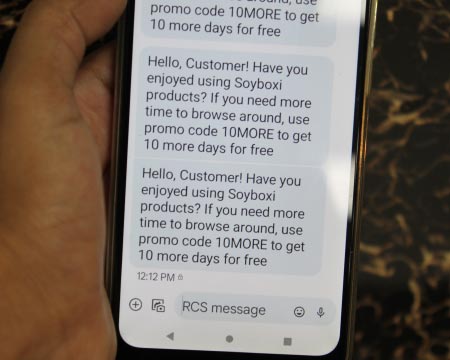Some Measures of The Success of SMS Marketing Campaign
-
Conversion Rates:
Conversion rates are the percentage of people who take the desired action after receiving your SMS message. This could be making a purchase, signing up for a service, or visiting your website.
To measure your conversion rates, you can track how many people click on links in your SMS messages, how many people complete a purchase, or how many people sign up for your service. You can also use A/B testing to compare different approaches and see which messages are most effective at driving conversions.
-
Click-Through Rates:
Click-through rates are the percentage of people who click on a link in your SMS message. This is a good indication of how engaged your audience is with your message and how effective your call-to-action is.
To increase your click-through rates, you can include a clear call-to-action and a compelling reason to click on the link. You can also test different approaches, such as using different words or phrases in your call-to-action or offering different incentives.
-
Opt-in Rates:
The first metric to consider is your opt-in rate. This is the percentage of people who have opted in to receive your SMS messages. The higher your opt-in rate, the more engaged your audience is likely to be, and the more effective your campaign will be overall.
To increase your opt-in rate, you can offer incentives to encourage people to sign up, such as exclusive discounts or early access to new products. You can also make it easy for people to opt-in by including a clear call-to-action and a simple opt-in process.
-
Redemption Rates:
Redemption rates are the percentage of people who take advantage of a promotion or offer included in your SMS message. This is a good way to measure the effectiveness of your promotions and to see which ones are most appealing to your audience.
To increase your redemption rates, you can offer compelling promotions or incentives, such as exclusive discounts or limited-time offers. You can also make it easy for people to redeem the promotion, such as by including a coupon code or a link to a landing page.
-
Return on Investment:
Return on investment (ROI) is a measure of the overall effectiveness of your SMS marketing campaign. It takes into account the costs of your campaign, such as the cost of sending SMS messages, as well as the revenue generated by the campaign.
To calculate your ROI, you can divide the revenue generated by your campaign by the cost of the campaign. This will give you a ratio that indicates whether your campaign is profitable or not.
In addition to these metrics, you can also use surveys and feedback forms to gather qualitative data about the effectiveness of your SMS marketing campaigns. By asking your audience for their feedback, you can gain valuable insights into what is working and what is not, and use this information to improve future campaigns.
Some Common Mistakes to Avoid in SMS Marketing

SMS marketing can be a highly effective way to reach customers and drive engagement, but there are several common mistakes that businesses should avoid. Here are some of the most common mistakes to avoid in SMS marketing:
-
Sending too many messages:
Sending too many messages can quickly become annoying for recipients, leading to high opt-out rates and a negative perception of your brand. It's important to strike a balance between staying top of mind and overwhelming your audience.
-
Not getting permission:
Before sending any marketing messages, it's crucial to obtain explicit consent from recipients. This can be done through opt-in forms on your website, through mobile apps, or via text message.
-
Failing to provide value:
Customers are more likely to engage with messages that provide value, whether it's a discount, exclusive content, or relevant information. Failing to provide value can result in low engagement and high opt-out rates.
-
Ignoring message frequency regulations:
Different countries have different regulations on how often businesses can send marketing messages. It's important to familiarize yourself with these regulations and comply with them to avoid legal issues.
-
Failing to segment your audience:
Sending the same message to your entire audience regardless of their interests or behavior can result in low engagement and high opt-out rates. Segmenting your audience based on demographics, behavior, and interests can help you send targeted and relevant messages.
-
Not including an opt-out option:
Including an opt-out option in your messages is not only a legal requirement but also a best practice. Customers appreciate the ability to opt-out of messages they're no longer interested in, and including an opt-out option can help improve your brand reputation.
-
Ignoring timing and frequency:
The timing and frequency of your messages are crucial to their effectiveness. Sending messages at inappropriate times or too frequently can lead to high opt-out rates and a negative perception of your brand.
-
Failing to test and optimize:
Testing and optimizing your messages can help improve their effectiveness over time. This can include testing different message formats, offers, and timing to determine what resonates best with your audience.
📝 In conclusion, SMS marketing can be a highly effective way to reach customers and drive engagement, but it's important to avoid common mistakes. Sending too many messages, not getting permission, failing to provide value, ignoring message frequency regulations, failing to segment your audience, not including an opt-out option, ignoring timing and frequency, and failing to test and optimize are some of the common mistakes to avoid in SMS marketing. By avoiding these mistakes and focusing on delivering value to your audience, you can create a successful SMS marketing campaign.
The Regulations and Guidelines for SMS Marketing
SMS marketing, like any other form of marketing, is subject to regulations and guidelines to protect consumers from unwanted messages and privacy violations. In this article, we will explore the key regulations and guidelines that businesses need to follow to conduct SMS marketing campaigns in compliance with the law.
-
Follow CTIA Guidelines:
The Cellular Telecommunications and Internet Association (CTIA) is an industry association that provides guidelines for SMS marketing. The CTIA guidelines include recommendations for obtaining consent, providing opt-out mechanisms, and limiting the sending frequency.
-
Provide an Opt-Out Mechanism:
An opt-out mechanism must be provided with every SMS message. This mechanism must be easy to use, and it must allow the recipient to stop receiving messages immediately. The opt-out mechanism can be as simple as replying "STOP" to the SMS message.
-
Be Transparent and Honest:
Businesses must be transparent and honest in their SMS marketing messages. This means that they should clearly identify themselves and the purpose of the message. SMS messages must not be misleading or deceptive.
-
Limit Sending Frequency:
Businesses should not send SMS messages too frequently. This can be annoying for recipients and lead to opt-outs. It is recommended to limit the number of messages to one or two per week.
-
Provide Value:
SMS messages must provide value to the recipient. This can be in the form of discounts, promotions, or exclusive offers. The message should be relevant and timely, and it should address the recipient's needs and interests.
-
Protect Data:
Businesses must protect the data of their customers. This means that they must store the data securely and only use it for the purpose for which it was collected. They must also ensure that the data is accurate and up-to-date.
-
Follow TCPA Guidelines:
The Telephone Consumer Protection Act (TCPA) is a federal law that regulates telemarketing and SMS marketing. The TCPA requires businesses to obtain express written consent from recipients before sending SMS messages for marketing purposes. It also requires businesses to provide an opt-out mechanism with every SMS message.
-
Obtain Consent:
Before sending SMS messages to customers, businesses must obtain express consent from recipients. This consent can be obtained through various means, such as opt-in forms, checkboxes, and online forms. The consent form must clearly state the type of messages that the recipient will receive, the frequency of messages, and how to opt-out of future messages.
-
Follow GDPR Guidelines:
The General Data Protection Regulation (GDPR) is a European Union law that regulates data protection and privacy. It requires businesses to obtain explicit consent from recipients before sending SMS messages for marketing purposes. It also requires businesses to provide an opt-out mechanism with every SMS message.
📝 In conclusion, SMS marketing can be a highly effective way to reach customers and promote products and services. However, it is important for businesses to follow the regulations and guidelines outlined above to ensure that their SMS marketing campaigns are compliant with the law and respect the privacy of their customers.
Personalize SMS Marketing Messages for the Audience
Personalization is a crucial aspect of any marketing strategy, including SMS marketing. Personalized messages tend to have a higher engagement rate as they make customers feel valued and understood. Here are some ways to personalize your SMS marketing messages for your audience:

-
Segment your audience: Segmenting your audience based on demographics, behavior, and interests can help you send targeted and relevant messages. For example, if you have a clothing store, you can send promotions for winter coats to customers who live in cold climates and send swimwear promotions to customers in warmer climates.
-
Refer to past purchases: Referring to the recipient's past purchases can show that you understand their preferences and needs. For example, if a customer has previously purchased running shoes, you can send them a message about a new line of running gear.
-
Send personalized recommendations: Based on the recipient's past purchases or browsing history, you can send them personalized product recommendations. For example, if a customer has previously bought a red dress, you can send them a message about matching accessories.
-
Use personal pronouns: Using personal pronouns such as "you" and "your" can make the message feel more personal and directed towards the recipient.
-
Ask for feedback: Ask for feedback from the recipient to show that you value their opinion and are interested in improving their experience with your brand.
-
Timing: Send messages at the appropriate time based on the recipient's location and time zone. For example, if you have a promotion for breakfast items, it's best to send it in the morning.
-
Use the recipient's name: Including the recipient's name in the message can make it feel more personal and increase the chances of them engaging with the message.
-
Include personalized promotions: Including promotions or discounts that are personalized to the recipient's interests or past purchases can increase the chances of them engaging with the message.
